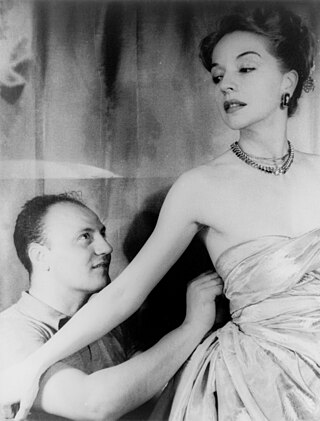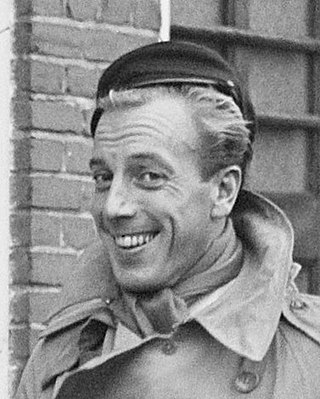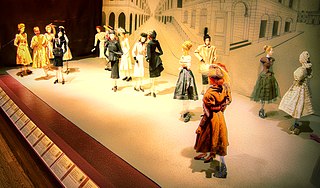
Pierre Cardin, born Pietro Costante Cardin, was an Italian-born naturalised-French fashion designer. He is known for what were his avant-garde style and Space Age designs. He preferred geometric shapes and motifs, often ignoring the female form. He advanced into unisex fashions, sometimes experimental, and not always practical. He founded his fashion house in 1950 and introduced the "bubble dress" in 1954.

Sir Norman Bishop Hartnell was a leading British fashion designer, best known for his work for the ladies of the royal family. Hartnell gained the Royal Warrant as Dressmaker to Queen Elizabeth in 1940, and Royal Warrant as Dressmaker to Queen Elizabeth II in 1957. Princess Beatrice also wore a dress designed for Queen Elizabeth II by Hartnell for her wedding in 2020.

Jean Paul Gaultier is a French haute couture and prêt-à-porter fashion designer.

Chanel is a luxury fashion house founded in 1910 by Coco Chanel in Paris. It is privately owned by French brothers, Alain and Gérard Wertheimer, through the holding company Chanel Limited, established in 2018 and headquartered in London.

A dressmaker, also known as a seamstress, is a person who makes clothing for women, such as dresses, blouses, and evening gowns. Dressmakers were historically known as mantua-makers, and are also known as a modiste or fabrician.

Nicole Miller is an American fashion designer and businesswoman.

James Galanos was an American fashion designer and couturier. Galanos is known for designing clothing for America's social elite, including Nancy Reagan, Marilyn Monroe, Elizabeth Taylor, and others.

Manfred Thierry Mugler was a French fashion designer, creative director and creative adviser of Mugler. In the 1970s, Mugler launched his eponymous fashion house; and quickly rose to prominence in the following decades for his avant-garde, architectural, hyperfeminine and theatrical approach to haute couture. He was one of the first designers to champion diversity in his runway shows, which often tackled racism and ageism, and incorporated non-traditional models such as drag queens, porn stars, and transgender women. In 2002, he retired from the brand, and returned in 2013 as the creative adviser.

History of fashion design refers specifically to the development of the purpose and intention behind garments, shoes, accessories, and their design and construction. The modern industry, based around firms or fashion houses run by individual designers, started in the 19th century with Charles Frederick Worth who, beginning in 1858, was the first designer to have his label sewn into the garments he created.

Jacques Fath was a French fashion designer who was considered one of the three dominant influences on postwar haute couture, the others being Christian Dior and Pierre Balmain. The playwright Georges Fath was his great-grandfather.
Pierre Balmain S.A., trading as Balmain, is a French luxury fashion house that was founded by Pierre Balmain (1914–1982) in 1945.

Tatiana Sorokko is a Russian-born American model, fashion journalist, and haute couture collector. She walked the runways for the world's most prominent designers and fashion houses, appeared on covers of leading fashion magazines, and became the first Russian model of the post-Soviet period to gain international recognition. After modeling, Sorokko worked as contributing editor for Vogue, Vanity Fair and Harper's Bazaar. Her distinct personal style and her private collection of historically important haute couture clothing were subjects of museum exhibitions in Russia and the U.S.

Haute couture is the creation of exclusive custom-fitted high-end fashion design. The term haute couture generally refers to a specific type of upper garment common in Europe during the 16th to the 18th century, or to the upper portion of a modern dress to distinguish it from the skirt and sleeves. Beginning in the mid-nineteenth century, Paris became the centre of a growing industry that focused on making outfits from high-quality, expensive, often unusual fabric and sewn with extreme attention to detail and finished by the most experienced and capable of sewers—often using time-consuming, hand-executed techniques. Couture translates literally from French as "dressmaking", sewing, or needlework and is also used as a common abbreviation of haute couture and can often refer to the same thing in spirit.

Germaine Cellier (1909–1976) was a French perfumer. She was known for creating bold, pioneering fragrances such as Fracas and Bandit. Cellier was also one of the first prominent female perfumers, at a time when the industry was dominated by men.
Madame Grès (1903–1993), also known as Alix Barton and Alix, was a leading French couturier and costume designer, founder of haute couture fashion house Grès as well as the associated Parfums Grès. Remembered as the "Sphinx of Fashion", Grès was notoriously secretive about her personal life and was seen as a workaholic with a furious attention to detail, preferring to let her work do the talking. Grès, best known for her floor-length draped Grecian goddess gowns, is noted as the "master of the wrapped and draped dress" and the "queen of drapery". Grès's minimalistic draping techniques and her attention to and respect for the female body have had a lasting effect on the haute couture and fashion industry, inspiring a number of recent designers.

Théâtre de la Mode was a 1945–1946 touring exhibit of fashion mannequins created at approximately 1/3 the size of human scale, and crafted by top Paris fashion designers.It was created to raise funds for war survivors and to help revive the French fashion industry in the aftermath of World War II. While raising funds, Théâtre de la Mode was also meant to showcase the work of Parisian couturiers. The original Théâtre de la Mode exhibit toured Europe and then the United States, and is now part of the permanent collections of the Maryhill Museum of Art in Washington state in the United States. In addition to its fundraising and industry revival goals, the Théâtre de la Mode exhibit played a significant role in promoting French fashion internationally. The miniature mannequins and exquisite designs showcased the creativity and craftsmanship of Parisian couturiers, attracting attention and admiration from fashion enthusiasts worldwide. The exhibit's subsequent journey to the United States helped solidify the global influence of French fashion and contributed to the post-war cultural exchange between Europe and America.

The House of Worth was a French fashion house that specialized in haute couture, ready-to-wear clothes, and perfumes. It was founded in 1858 by English designer Charles Frederick Worth. It continued to operate under his descendants until 1952 and closed in 1956. Between 2010 and 2013 there was an attempt to relaunch the House of Worth as a fashion brand.

Robert Piguet was a Swiss-born, Paris-based fashion designer who is mainly remembered for training Christian Dior and Hubert de Givenchy. The Piguet fashion house ran from 1933 to 1951; since then, the brand Robert Piguet has been associated exclusively with fragrances.
Hervé Pierre Braillard, known as Hervé Pierre,, is a French-American fashion and costume designer. In 1987, he received the first Christian Dior award from the Comité Colbert. Pierre has designed fashions for four United States first ladies since the 1990s: Hillary Clinton, Laura Bush, Michelle Obama, and Melania Trump.
Victor Joris (1929–2013) was an American fashion designer and fashion illustrator. He was active between 1945 until the 1970s.
















